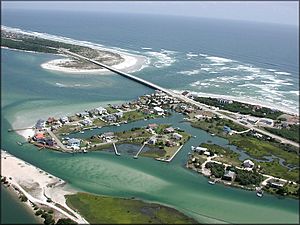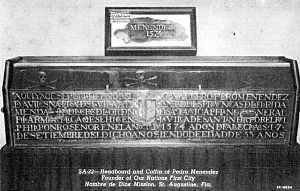Massacre at Matanzas Inlet facts for kids

The Massacre at Matanzas Inlet was the killing of French troops by Spanish troops near the Matanzas Inlet in 1565, at the order of Pedro Menéndez de Avilés, adelantado of Spanish Florida (La Florida).
The Spanish Crown in the 16th century laid claim to a vast area that included what is now the state of Florida, along with much of what is now the southeastern United States, on the strength of several Spanish expeditions made in the first half of the 1500s, including those of Ponce de Leon and Hernando de Soto. However, Spanish attempts to establish a lasting presence in La Florida failed until September 1565, when Menéndez founded St. Augustine about 30 miles south of the newly established French settlement at Fort Caroline on the St. Johns River. Menéndez had not known that the French had already arrived in the area, and upon discovering the existence of Fort Caroline, he aggressively moved to expel those whom he considered heretics and intruders.
When the French Huguenot leader, Jean Ribault, learned of the Spanish presence nearby, he also decided on a swift assault and sailed south from Fort Caroline with most of his troops to search for the Spanish settlement. His ships were struck by a storm (probably a tropical storm) and most of the French force was lost at sea, leaving Ribault and several hundred survivors in two groups shipwrecked with limited food and supplies: one group about 15 miles south of the Spanish colony, and Ribault's group much farther southward at Cape Canaveral. Meanwhile, Menéndez marched north, overwhelmed the remaining defenders of Fort Caroline, massacred most of the French Protestants in the town, and left an occupying force in the rechristened Fort Mateo. Upon returning to St. Augustine, he received news that Ribault and his troops were stranded to the south. Menéndez quickly moved to attack and massacred the French force of two separate parties on the shore of what became known as the Matanzas River, sparing only the Catholics and a few skilled workmen among the French.
Repercussions of the massacre
That same night Menéndez returned to St. Augustine; and when the event became known, there were some in that isolated garrison, living in constant apprehension of an attack by the French, who considered him cruel, an opinion which his brother-in-law, Merás, who helped to kill Ribault, did not hesitate to record. And when the news eventually reached Spain, even there a vague rumor was afloat that there were those who condemned Menéndez for perpetrating the massacre against his given word. Others among the settlers thought that he had acted as a good captain, because, with their small store of provisions, they considered that there would have been an imminent danger of their perishing by hunger had their numbers been increased by the Frenchmen, even had they been Catholics.
Bartolomé Barrientos, Professor at the University of Salamanca, whose history was completed two years after the event, expressed still another current of Spanish contemporary opinion:
"He acted as an excellent inquisitor; for when asked if they were Catholics or Lutherans, they dared to proclaim themselves publicly as Lutherans, without fear of God or shame before men; and thus he gave them that death which their insolence deserved. And even in that he was very merciful in granting them a noble and honourable death, by cutting off their heads, when he could legally have burnt them alive."
The motives which impelled Menéndez to commit these deeds of blood should not be attributed exclusively to religious fanaticism, or to racial hatred. The position subsequently taken by the Spanish Government in its relations with France to justify the massacre turned on the large number of the French and the fewness of the Spaniards; the scarcity of provisions, and the absence of ships with which to transport them as prisoners. These reasons do not appear in the brief accounts contained in Menéndez's letter of 15 October 1565, but some of them are explicitly stated by Barrientos. It is probable that Menéndez clearly perceived the risk he would run in granting the Frenchmen their lives and in retaining so large a body of prisoners in the midst of his colonists: it would be a severe strain upon his supply of provisions and seriously hamper the dividing up of his troops into small garrisons for the forts which he contemplated erecting at different points along the coast.
Philip wrote a comment on the back of a dispatch from Menéndez in Havana, of 12 October 1565: "As to those he has killed he has done well, and as to those he has saved, they shall be sent to the galleys." In his official utterances in justification of the massacre Philip laid more stress on the contamination which heresy might have brought among the native peoples than upon the invasion of his dominions.
On his return to St. Augustine Menéndez wrote to the King a somewhat cursory account of the preceding events and summarized the results in the following language:
The other people with Ribault, some seventy or eighty in all, took to the forest, refusing to surrender unless I grant them their lives. These and twenty others who escaped from the fort, and fifty who were captured by the Indians, from the ships which were wrecked, in all one hundred and fifty persons, rather less than more, are [all] the French alive to-day in Florida, dispersed and flying through the forest, and captive with the Indians. And since they are Lutherans and in order that so evil a sect shall not remain alive in these parts, I will conduct myself in such wise, and will so incite my friends, the Indians, on their part, that in five or six weeks very few if any will remain alive. And of a thousand French with an armada of twelve sail who had landed when I reached these provinces, only two vessels have escaped, and those very miserable ones, with some forty or fifty persons in them.
Ever since 12 October 1565, when Jean Ribault and the remainder of the French Huguenots who survived the wreck of Ribault's fleet were massacred by Menéndez, the inlet where the deed occurred has been known as Matanzas, meaning "slaughters" in Spanish.
Fort Matanzas, the Matanzas River, and the Matanzas Inlet all derive their name from the massacre.


